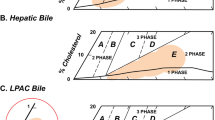Abstract
This study examined the effect of castration and dietary hormonal supplementation on cholesterol cholelithiasis in male hamsters. Animals fed a standard lithogenic diet developed cholesterol gallstones (17%) after 6 wk, while castrated hamsters did not form any stones. Addition of a synthetic androgen, methyltestosterone, to the lithogenic diet induced cholelithiasis in castrated animals (50%). The biles of normal and castrated-hormone supplemented hamsters had cholesterol saturation indices of 1.0 and 1.1, respectively, while the bile of the castrated animals remained unsaturated (0.6). The ratio of cholic acid/chenodeoxycholic acid in bile increased after castration, but returned to normal levels following hormonal supplementation. Biliary cholesterol carriers were separated by ultracentrifugation. Animals in the stone-forming groups (normal and castrated-hormone treated) had a significant proportion of their biliary cholesterol in vesicles (44 and 46%, respectively); castrated hamsters had less cholesterol in vesicle form (9%). The molar ratio of cholesterol/phospholipid in vesicles was reduced after castration (0.93 vs. 0.42) and increased by hormonal supplementation (1.89). In conclusion, when compared to normal male hamsters fed a standard lithogenic diet, castration reduced the cholesterol saturation of bile, lowered the vesicular/micellar ratio in bile, and inhibited cholesterol cholelithiasis. Dietary androgen supplementation increased the lithogenicity of bile, resulting in stone formation in castrated animals.
Similar content being viewed by others
Abbreviations
- CA:
-
cholic acid
- CDCA:
-
chenodeoxycholic acid
- CSI:
-
cholesterol saturation index
- DCA:
-
deoxycholic acid
- EE:
-
ethinylestradiol
- LCA:
-
lithocholic acid
- LD:
-
lithogenic diet
- MeT:
-
methyltestosterone
References
Diehl, A.K. (1991) Epidemiology and Natural History of Gallstone Disease, inGastroenterology Clinics of North America (Cooper, A.D., ed.) Vol. 20, pp. 1–19, W.B. Saunders Company, Philadelphia.
Boston Collaborative Drug Surveillance Program (1973) Oral Contraceptives and Venous Thromboembolic Disease, Surgically Confirmed Gallbladder Disease, and Breast Tumours,Lancet 1, 1399–1404.
Boston Collaborative Drug Surveillance Program (1974) Surgically Confirmed Gallbladder Disease, Venous Thromboembolism, and Breast Tumors in Relation to Postmenopausal Estrogen Therapy,N. Engl. J. Med. 290, 15–19.
Henriksson, P., Einarsson, K., Eriksson, A., Kelter, U., and Angelin, B. (1989) Estrogen-Induced Gallstone Formation in Males. Relation to Changes in Serum and Biliary Lipids During Hormonal Treatment of Prostatic Carcinoma.J. Clin. Invest. 84, 811–816.
Cohen, B.I., Matoba, N., Mosbach, E.H., and McSherry, C.K. (1989) Dietary Induction of Cholesterol Gallstones in Hamsters from Three Different Sources,Lipids 24, 151–156.
Ayyad, N., Cohen, B.I., Mosbach, E.H., Miki, S., Mikami, T., Mikami, Y., and Stenger, R.J. (1993) Age, Sex and Source of Hamster Affect Experimental Cholesterol Cholelithiasis,Lipids, 28, 981–986.
Ayyad, N., Cohen, B.I., Mosbach, E.H., Mikami, T., Mikami, Y., and Ohshima, A. (1995) Hormonal Control of Cholesterol Cholelithiasis in the Female Hamster,J. Lipid Res. 36, 1483–1488.
Cohen, B.I., Singhal, A.K., Stenger, R.J., May-Donath, P., Finver-Sadowsky, J., McSherry, C.K., and Mosbach, E.H. (1984) Effects of Chenodeoxycholic and Ursodeoxycholic Acids on Lipid Metabolism and Gallstone Formation in the Prairie Dog.Hepatology 4, 300–307.
Cohen, B.I., Raicht, R.F., and Mosbach, E.H. (1977) Sterol Metabolism Studies in the Rat. Effects of Primary Bile Acids (sodium taurochenodeoxycholate and sodium taurocholate) on Sterol Metabolism,J. Lipid Res. 18, 223–231.
Zar, J.H. (1984)Biostatistical Analysis, 2nd edn., pp. 62–64; 101–103; 162–184, Prentice-Hall, Englewood Cliffs, NJ.
Kuroki, S., Cohen, B.I., Carey, M.C., and Mosbach, E.H. (1986) Rapid Computation with the Personal Computer of the Percent Cholesterol Saturation of Bile Samples,J. Lipid Res. 27, 442–446.
Carey, M.C. (1978) Critical Tables for Calculating the Cholesterol Saturation of Native Bile,J. Lipid Res. 19, 945–955.
Berr, F., Stellaard, F., Goetz, A., Hammer, C., and Paumgartner, G. (1988) Ethinylestradiol Stimulates a Biliary Cholesterol-Phospholipid Cosecretion Mechanism in the Hamster,Hepatology 8, 619–624.
Pealrman, B.J., Bonorris, G.G., Phillips, M.J., Chung, A., Vimadalal, S., Marks, J.W., and Schoenfield, L.J. (1979) Cholesterol Gallstone Formation and Prevention by Chenodeoxycholic and Ursodeoxycholic Acids. A New Hamster Model,Gastroenterology 77, 634–641.
Nervi, F.O., Pozo, R.D., Covarrubias, C.F., and Ronco, B.O. (1983) The Effect of Progesterone on the Regulatory Mechanisms of Biliary Cholesterol Secretion in the Rat,Hepatology 3, 360–367.
Gilloteaux, J., Kosek, E., and Kelly, T.R. (1993) Sex Steroid Induction of Gallstones in the Male Syrian Hamster,J. Submicrosc. Cytol. Pathol. 25, 157–172.
Kuroki, S., Muramoto, S., Kuramoto, T., and Hoshita, T. (1983) Sex Differences in Gallbladder Bile Acid Composition and Hepatic Steroid 12α-Hydroxylase Activity in Hamsters,J. Lipid Res. 24, 1543–1549.
Gurantz, D., and Hofmann, A.F. (1984) Influence of Bile Acid Structure on Bile Flow and Biliary Lipid Secretion in the Hamster.Am. J. Physiol. 247, G736-G748.
Halpern, Z., Dudley, M.A., Kibe, A., Lynn, M.P., Breuer, A.C., and Holzbach, R.T. (1986) Rapid Vesicle Formation and Aggregation in Abnormal Human Biles. A Time-Lapse Video-Enhanced Contrast Microscopy Study,Gastroenterology 90, 875–885.
Peled, Y., Halpern, Z., Eitan, B., Goldman, G., Konikoff, F., and Gilat, T. (1989) Biliary Micellar Cholesterol Nucleatesvia the Vesicular Pathway,Biochim. Biophys. Acta. 1003, 246–249.
Gilat, T., Halpern, Z., Peled, Y., and Sömjen, G. (1990) Metastability of Cholesterol Carriers in Bile and the Pathogenesis of Cholesterol Gallstones,Gastroenterol. Intl. 3, 81–86.
Halpern, Z., Dudley, M.A., Lynn, M.P., Nader, J.M., Breuer, A.C., and Holzbach, R.T. (1986) Vesicle Aggregation in Model Systems of Supersaturated Bile: Relation to Crystal Nucleation and Lipid Composition of the Vesicular Phase,J. Lipid Res. 27, 295–306.
Kibe, A., Dudley, M.A., Halpern, Z., Lynn, M.P., Breuer, A.C., and Holzbach, R.T. (1985) Factors Affecting Cholesterol Monohydrate Crystal Nucleation Time in Model Systems of Supersaturated Bile,J. Lipid Res. 26, 1102–1111.
Holzbach, R.T., Marsh, M., Olszewski, M., and Holan, K. (1973) Cholesterol Solubility in Bile. Evidence that Supersaturated Bile Is Frequent in Healthy Man,J. Clin. Invest. 52, 1467–1479.
Small, D.M. (1980) Cholesterol Nucleation and Growth in Gallstone Formation,N. Engl. J. Med. 302, 1305–1307.
Van Erpecum, K.J., Van Berge Henegouwen, G.P., Stoelwinder, B., Schmidt, Y.M.G., and Willekens, F.L.H. (1990) Bile Concentration Is a Key Factor for Nucleation of Cholesterol Crystals and Cholesterol Saturation Index in Gallbladder Bile of Gallstone Patients,Hepatology 11, 1–6.
Author information
Authors and Affiliations
About this article
Cite this article
Ohshima, A., Cohen, B.I., Ayyad, N. et al. Effect of Castration and hormonal supplementation on cholesterol cholelithiasis in the male hamster. Lipids 31, 945–948 (1996). https://doi.org/10.1007/BF02522687
Received:
Accepted:
Issue Date:
DOI: https://doi.org/10.1007/BF02522687




